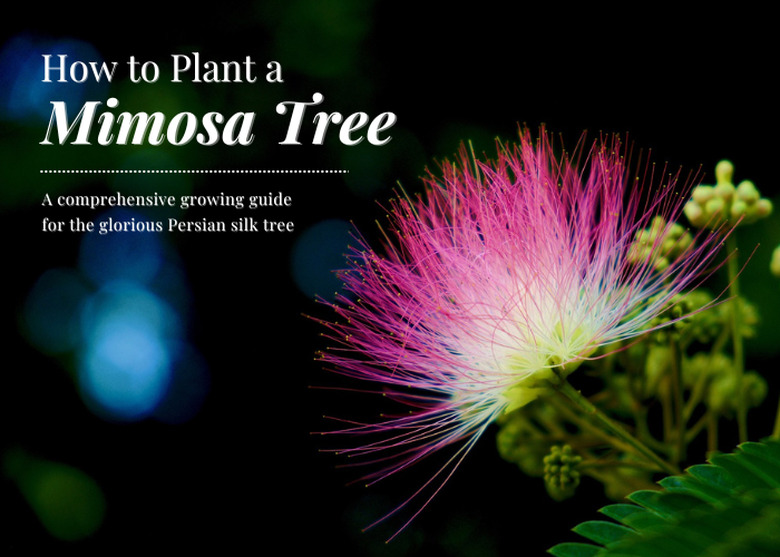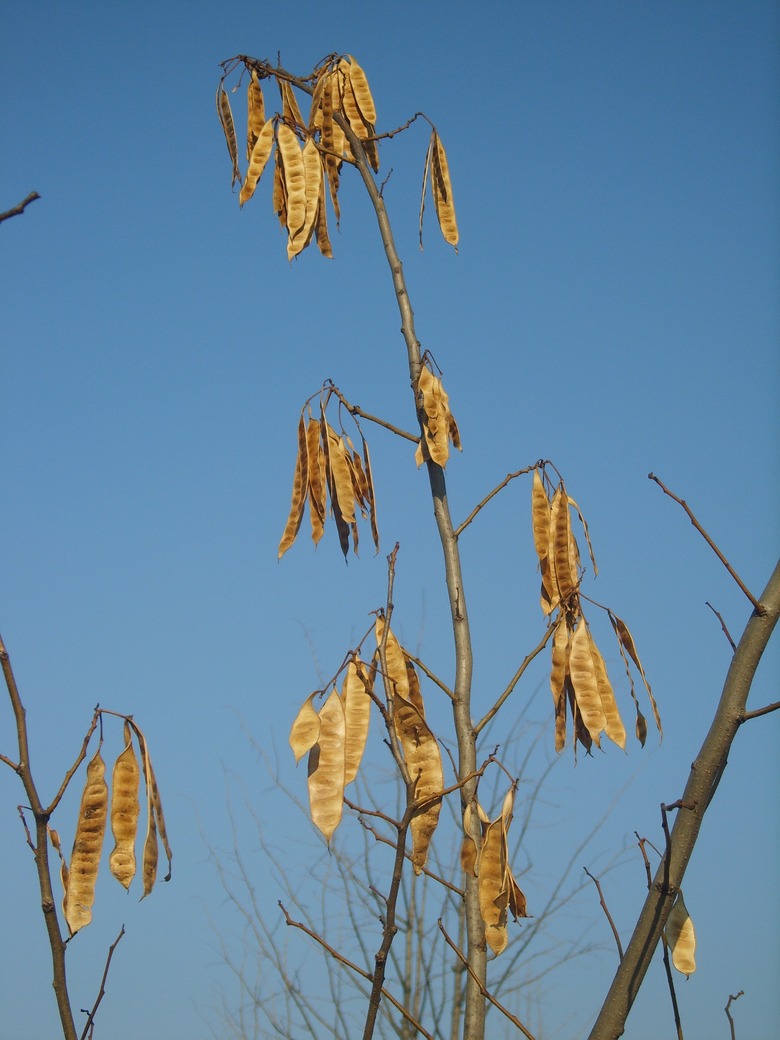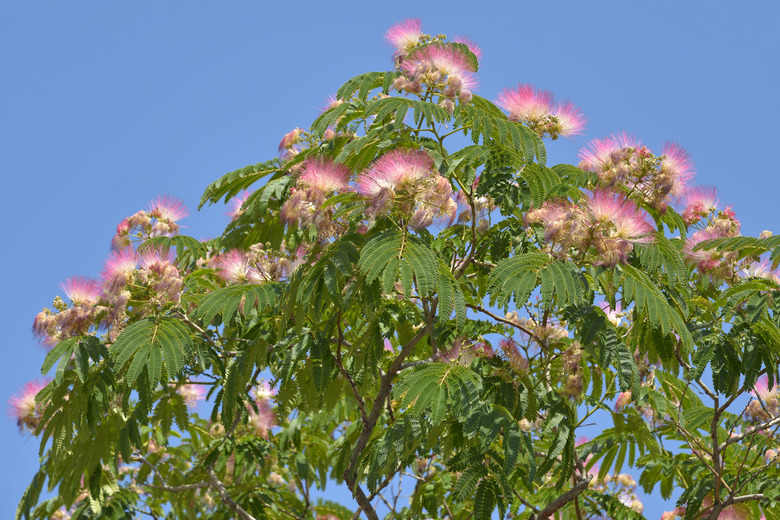Mimosa Tree Planting Instructions
The umbrella-like crown, fluttering leaves and fluffy fragrant flowers make mimosa trees (Albizia julibrissin) a popular choice for small landscapes or as a focal point in a rain garden. In addition to the leaf structure and flowers, mimosa tree identification is easy when the distinctive pods appear.
It's best to plant a bare-root mimosa tree in late winter or early spring when it is still dormant, although potted trees can be planted in early fall, six weeks before the first frost.
Plant Profile: Mimosa Tree
Native to Asia and the Middle East, from Japan to Iran, the mimosa tree is a fast-growing small tree that thrives in both well-drained and moist soils.
While short-lived—only 30 years on average—the powder puff flowers make it a focal point in the garden, attracting bees, butterflies and hummingbirds. After flowering, it produces 4- to 8-inch-long flat seedpods that stay on the tree into winter, providing visual interest and wildlife food.
- **Scientific name:** Albizia julibrissin
- **Plant family:** Pea, bean or legume family (Fabaceae or Leguminosae)
- **Common names:** Persian silk tree, pink silk tree, silk tree, mimosa tree
- **USDA hardiness zones:** 5-10, depending on the cultivar
- **Size:** 20–40 feet tall, 20–50 feet wide
- **Growth rate:** Fast, up to 3 feet per year
- **Sun exposure:** Full sun or part shade
- **Soil type:** All soil types, prefers well-drained or moist soils
- **Drought tolerance:** Medium water needs, tolerates drought
- **Invasive potential:** Yes
While there are a number of cultivars, the most cold-hardy mimosa tree is the 'EH Wilson Mimosa', hardy to -10°F in USDA zones 5 through 10. It produces bright pink flowers. Other cultivars, generally hardy in USDA zones 6-9, include the white-flowering 'Alba,' deep-pink flowering 'Rubra', and white and pink flowering 'Summer Chocolate', which features deep burgundy foliage. There is a weeping form, 'Ishii Weeping', and several disease-resistant cultivars, including 'Charlotte' and 'Tyron.'
Why should you be careful when planting a mimosa tree?
Although a mimosa tree is lovely, it is also messy and invasive.
Introduced into the United States in 1745 as an ornamental tree, it escaped cultivation. It has naturalized in the Southeast and along the West Coast in disturbed soil along roads, forest edges and waterways.
Mimosa trees drop a lot of leaves, faded flowers and seeds into the landscape, not to mention the sap from its foliage.
Germinating From Mimosa Tree Seedpods
Harvest the pods from the tree after they turn dry and brown. Cut the pods open and shake the dark brown seeds into a paper bag. Store in a cool, dry location until spring. Prepare the seeds by nicking or filing the hard outer shell and then soaking them in hot water overnight.
To germinate indoors, prepare biodegradable paper or peat pots. Place on a seed heat mat and fill with seed-starting mix or a mixture of sand and peat moss and moisten thoroughly. Plant the seeds, one per pot and 1 inch deep.
Alternately, place the pots outside in a warm, sunny location where they receive afternoon shade when temperatures rise above 90°F. Take the pots indoors if night temperatures drop toward 50°F.
Keep the pots in bright light or full sun until the seeds germinate in one to three weeks. Water carefully to avoid dislodging the developing seedlings, but keep the mix evenly moist.
Continue caring for the seedlings through summer, watering when the soil is dry to a depth of 1/2 inch. Transplant into the garden in early fall.
Growing a Mimosa Tree From a Cutting
To ensure an exact genetic clone of the desired cultivar, take 4- to 6-inch cuttings from the tree. Avoid using a flowering branch.
Remove the leaves from the bottom two-thirds of each cutting, dip them into water, and then swirl them in rooting compound. Insert the cuttings into 4-inch flowerpots filled with potting soil.
Cover the pots and cuttings with plastic bags supported by bamboo stakes to make miniature greenhouses. Place in a warm, brightly lit location.
Water as needed to keep the soil moist but not waterlogged until new growth and roots appear in three or more weeks. Remove the plastic bag and continue to water regularly as the cutting develops into a tree.
Transplanting a Mimosa Tree
Transplant the mimosa tree in early fall or bare root trees in early spring before they leaf out. Bare root trees may be planted in large containers or in the garden, at least 20 feet from hardscape and structures.
Where to Plant
Where to plant a mimosa tree varies depending on the climate. In the coldest hardiness zones, plant in wind-sheltered locations, preferably against a south-facing wall that can reflect the sun's rays to make a warmer microclimate. In hot climates, plant in light or dappled shade or where the young tree receives afternoon shade.
How to Plant
Dig a planting hole three times the root ball's width and slightly deeper. Loosen the soil in and around the hole, so the roots can spread into the surrounding soil.
Slide the tree out of the pot and cut any encircling, damaged or dead roots with pruners sterilized by dipping the blades in Lysol.
Place the tree at the same level as it was in the pot and backfill with the excavated soil. Tamp lightly and water thoroughly to ensure a firm contact between the roots and moist soil.
How to Care for a Mimosa Tree
The mimosa tree is drought-tolerant but grows and flowers best with regular watering.
Watering
Cover the bare soil around the tree, from the drip line of the canopy to 6 inches from the trunk with a coarse bark mulch.
Water when the soil is dry to the touch, daily if necessary for the first two weeks, and then reduce watering to every two to three days for another three to 12 weeks. Continue applying 1 to 2 inches of water weekly as needed, depending on rain or snowstorms.
Fertilizer
Wait one year and then fertilize in early spring before the leaves appear. After two to three years, reduce fertilizing to every other year. Mimosa trees fix nitrogen in the soil, like other legumes.
- Apply a balanced 10-10-10 fertilizer according to the package directions.
- Consider applying a 1- to 2-inch layer of compost around the tree, or leave the tree leaves and litter to decompose naturally.
- Water thoroughly after fertilizing.
Pruning
Prune the tree to shape into a single or multi-stemmed trunk.
Monitor for signs of mimosa wilt (Fusarium oxysporum f. sp. Perniciosum), which is the primary disease that infects mimosa trees. The leaves become yellow and fall from the tree, sometimes before the tree finishes flowering. Remove infected branches, bag them and discard them in the trash bin; do not compost. Generally, this fungal infection is fatal to the tree.
Tip
If fusarium or mimosa wilt is an issue in the area, plant disease-resistant cultivars like 'Charlotte' and 'Tyron.'
References
- North Carolina State Extension: Albizia Julibrissin
- Missouri Botanical Garden: Albizia Julibrissin
- University of Florida IFAS Extension: Albizia Julibrissin 'Alba': 'Alba' Mimosa Tree
- University of Minnesota Extension: Best Practices for Planting Trees and Shrubs
- Texas A&M AgriLife Extension: Texas Plant Disease Handbook – Mimosa


